Canon EOS 550D, EOS REBEL T2i User Manual
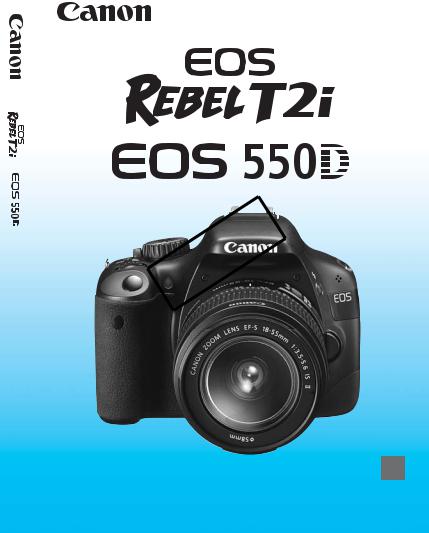
MANUAL INSTRUCTION
COPY
E
E |
The “Quick Reference Guide” and “Software Start Guide” are |
INSTRUCTION |
|
provided at end of this manual. |
MANUAL |
||
|
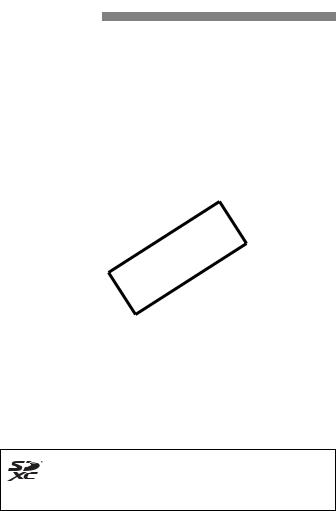
Introduction
The EOS REBEL T2i/EOS 550D is a high-performance, digital singlelens reflex camera featuring a fine-detail CMOS sensor with 18.0 effective megapixels, DIGIC 4, high-precision and high-speed 9-point AF, approx. 3.7 fps continuous shooting, Live View shooting, and Full HD (Full High-Definition) movie shooting.
The camera is highly responsive for shooting at anytime, provides many functions fitted for advanced shooting, and offers many other features.
Take Test Shots to Familiarize Yourself with the Camera
With a digital camera, you can immediately view the image you have captured. While reading this manual, take a few test shots and see how they come out. You can then better understand the camera.
To avoid botched pictures and accidents, first read the Safety Warnings (p.233, 234) and Handling Precautions (p.12,13).
Testing the Camera Before Use and Liability
After shooting, playback and check whether the images have been properly recorded. If the camera or memory card is faulty and the
images cannot be recorded or downloaded to a computer, Canon |
|
cannot be held liable for any loss or inconvenience caused. |
|
Copyrights |
COPY |
Copyright laws in your country may prohibit the use of your recorded images of people and certain subjects for anything but private enjoyment. Also be aware that certain public performances, exhibitions, etc., may prohibit photography even for private enjoyment.
This camera is compatible with SD memory cards, SDHC memory cards, and SDXC memory cards. This manual will refer to all these cards as just “card.”
*The camera does not come with a card for recording images.
Please purchase it separately.
2
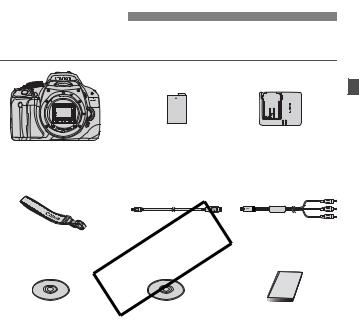
Item Check List
Before starting, check that all the following items have been included with your camera. If anything is missing, contact your dealer.
Camera |
Battery Pack |
Battery Charger |
LP-E8 |
LC-E8/LC-E8E* |
|
(with eyecup and body cap) |
(with protective cover) |
|
Wide Strap |
COPY |
Stereo AV Cable |
Interface cable |
||
EW-100DB III |
|
AVC-DC400ST |
EOS DIGITAL |
Software Instruction |
Camera |
Solution Disk |
Manual |
Instruction Manual |
(Software) |
|
(this booklet) |
*Battery Charger LC-E8 or LC-E8E is provided. (The LC-E8E comes with a power cord.)
If you purchased a Lens Kit, check that the lens is included.
Depending on the Lens Kit type, the lens instruction manual might also be included.
Be careful not to lose any of the above items.
3
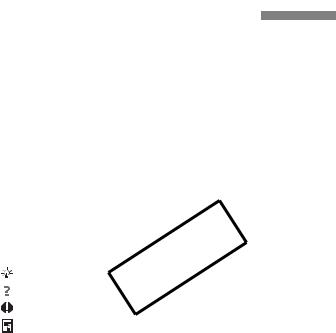
Conventions Used in this Manual 
Icons in this Manual
<6> |
: Indicates the Main Dial. |
<V> <U> |
: Indicates the <S> cross keys. |
<0> |
: Indicates the setting button. |
0, 9, 7, 8: Indicates that the respective function remains active for 4 sec., 6 sec., 10 sec., or 16 sec. respectively after you let go of the button.
*In this manual, the icons and markings indicating the camera’s buttons, dials, and settings correspond to the icons and markings on the camera and on the LCD monitor.
3: Indicates a function which can be changed by pressing the <M> button and changing the setting.
M: When shown on the upper right of the page, it indicates that the function is availableCOPYonly in the Creative Zone modes (p.20).
: Supplemental information.
Basic Assumptions
All operations explained in this manual assume that the power switch has already been set to <1> (p.27).
It is assumed that all the menu settings and Custom Functions are set to the default.
For explanatory purposes, the instructions show the camera attached with an EF-S18-55mm f/3.5-5.6 IS lens.
4
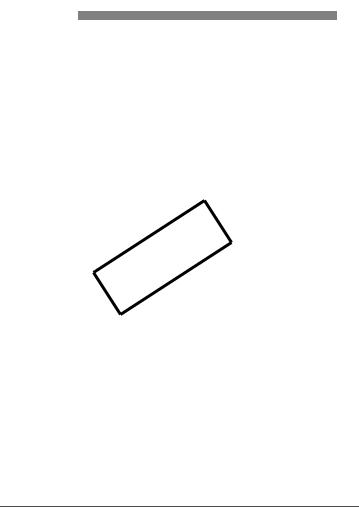
Chapters
For first-time DSLR users, Chapters 1 and 2 explain the camera’s basic operations and shooting procedures.
|
Introduction |
2 |
|
|
|
||
|
Camera basics. |
|
|
|
|
|
|
|
|
|
|
1 |
Getting Started |
23 |
|
|
|||
|
|
|
|
|
|
|
|
2 |
Basic Shooting and Image Playback |
45 |
|
|
|||
Fully automatic shooting for different subjects. |
|
||
|
|
||
|
|
|
|
3 |
Creative Shooting |
59 |
|
|
|||
Basic shooting features for specific types of subjects. |
|
||
|
|
||
|
|
|
|
4 |
Advanced Shooting |
77 |
|
|
|||
COPY |
|
||
Advanced shooting features. |
|
|
|
5 |
Shooting with the LCD Monitor (Live View Shooting) |
107 |
|
|
|
|
|
6 |
Shooting Movies |
123 |
|
|
|||
|
|
|
|
7 |
Handy Features |
137 |
|
|
|||
Convenient menu-based functions. |
|
||
|
|
||
|
|
|
|
8 |
Image Playback |
155 |
|
|
|||
|
|
|
|
9 |
Printing Images |
175 |
|
|
|||
|
|
|
|
10 |
Customizing the Camera |
189 |
|
|
|||
|
|
|
|
11 |
Reference |
201 |
|
|
|||
|
|
|
|
End Pages: Quick Reference Guide and Software Start Guide 243 
5
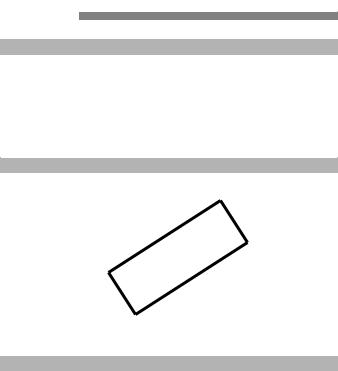
Contents |
|
|
|
Introduction |
2 |
|
Item Check List.................................................................................................. |
3 |
|
Conventions Used in this Manual...................................................................... |
4 |
|
Chapters............................................................................................................ |
5 |
|
Contents at a Glance....................................................................................... |
10 |
|
Handling Precautions ...................................................................................... |
12 |
|
Quick Start Guide ............................................................................................ |
14 |
|
Nomenclature .................................................................................................. |
16 |
1 |
Getting Started |
23 |
|
Charging the Battery ....................................................................................... |
24 |
|
Installing and Removing the Battery................................................................ |
26 |
|
Turning on the Power ...................................................................................... |
27 |
|
Setting the Date and Time............................................................................... |
29 |
|
Selecting the Interface Language.................................................................... |
30 |
|
Installing and Removing the SD Card ............................................................. |
31 |
|
Attaching and Detaching a Lens ..................................................................... |
33 |
|
About the Lens Image Stabilizer...................................................................... |
35 |
|
Basic Operation............................................................................................... |
36 |
|
QUsing the Quick Control Screen ................................................................ |
38 |
|
3Menu OperationsCOPY.................................................................................. |
40 |
|
Formatting the Card......................................................................................... |
42 |
|
Switching the LCD Monitor Display ................................................................. |
44 |
2 |
Basic Shooting and Image Playback |
45 |
|
1Fully Automatic Shooting........................................................................... |
46 |
|
1Full Auto Techniques................................................................................. |
48 |
|
7Disabling Flash.......................................................................................... |
49 |
|
2Shooting Portraits....................................................................................... |
50 |
|
3Shooting Landscapes................................................................................ |
51 |
|
4Shooting Close-ups .................................................................................... |
52 |
|
5Shooting Moving Subjects......................................................................... |
53 |
|
6Shooting Portraits at Night ......................................................................... |
54 |
|
CCreative Auto Shooting ............................................................................. |
55 |
|
xImage Playback......................................................................................... |
58 |
6
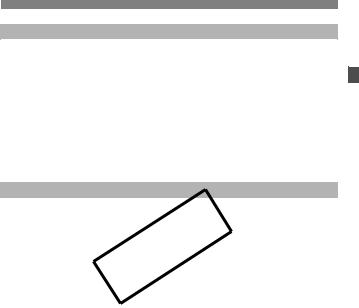
|
|
Contents |
3 |
Creative Shooting |
59 |
|
d: Program AE................................................................................................ |
60 |
|
Z: Changing the ISO Speed ......................................................................... |
62 |
|
DUsing the Built-in Flash ................................................................................ |
64 |
|
E: Changing the AF Mode ............................................................................. |
66 |
|
SSelecting the AF Point ............................................................................... |
68 |
|
MF: Manual Focusing ................................................................................... |
69 |
|
iContinuous Shooting .................................................................................. |
70 |
|
jUsing the Self-timer .................................................................................... |
71 |
|
Setting the Image-recording Quality................................................................. |
72 |
|
ASelecting a Picture Style .......................................................................... |
75 |
4 |
Advanced Shooting |
77 |
|
s: Action Shots ............................................................................................. |
78 |
|
f: Changing the Depth of Field .................................................................... |
80 |
|
Depth of Field Preview.................................................................................. |
82 |
|
a: Manual Exposure....................................................................................... |
83 |
|
8: Automatic Depth-of-Field AE................................................................ |
85 |
|
qChanging the Metering Mode..................................................................... |
86 |
|
OySetting Exposure ompensation....................................................... |
87 |
|
Auto Exposure BracketingCOPY................................................................................ |
89 |
|
ACustomizing a Picture Style ..................................................................... |
91 |
|
ARegistering a Picture Style....................................................................... |
94 |
|
Setting the Color Space ................................................................................... |
96 |
|
AAE Lock ...................................................................................................... |
97 |
|
AFE Lock....................................................................................................... |
98 |
|
B: Setting the White Balance ....................................................................... |
99 |
|
2White Balance Correction......................................................................... |
101 |
|
Auto Lighting Optimizer.................................................................................. |
103 |
|
Lens Peripheral Illumination Correction ......................................................... |
104 |
|
Preventing Camera Shake ............................................................................. |
106 |
7
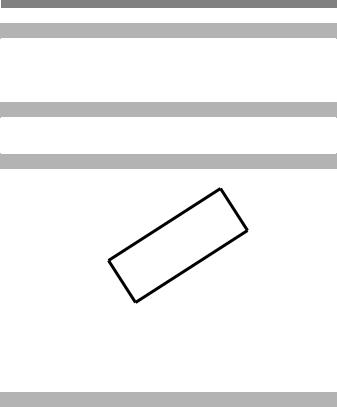
Contents |
|
|
5 |
Shooting with the LCD Monitor (Live View Shooting) |
107 |
|
AShooting with the LCD Monitor ............................................................... |
108 |
|
Shooting Function Settings ........................................................................... |
111 |
|
Using AF to Focus......................................................................................... |
113 |
|
Focusing Manually......................................................................................... |
120 |
6 |
Shooting Movies |
123 |
|
kShooting Movies...................................................................................... |
124 |
|
Shooting Function Settings ........................................................................... |
130 |
7 |
Handy Features |
137 |
|
Handy Features............................................................................................. |
138 |
|
Silencing the Beeper .................................................................................. |
138 |
|
Card Reminder ........................................................................................... |
138 |
|
Setting the Image Review Time ................................................................. |
138 |
|
COPY |
|
|
Setting the Auto Power-off Time................................................................. |
139 |
|
Adjusting the LCD Monitor Brightness ....................................................... |
139 |
|
File Numbering Methods ............................................................................ |
140 |
|
Auto Rotation of Vertical Images ................................................................ |
142 |
|
BChecking Camera Settings................................................................ |
143 |
|
Reverting the Camera to the Default Settings............................................ |
144 |
|
Preventing the LCD Monitor from Turning off Automatically ...................... |
146 |
|
Changing the Shooting Settings Screen Color........................................... |
146 |
|
Setting the Flash ........................................................................................... |
147 |
|
fAutomatic Sensor Cleaning ................................................................... |
150 |
|
Appending Dust Delete Data......................................................................... |
151 |
|
Manual Sensor Cleaning ............................................................................... |
153 |
8 Image Playback |
155 |
|
|
HISearching for Images Quickly.............................................................. |
156 |
|
u/yMagnified View.................................................................................... |
158 |
|
bRotating the Image................................................................................... |
159 |
|
kEnjoying Movies ...................................................................................... |
160 |
|
kPlaying Movies ........................................................................................ |
162 |
|
XEditing the Movie’s First and Last Scenes ............................................... |
164 |
8
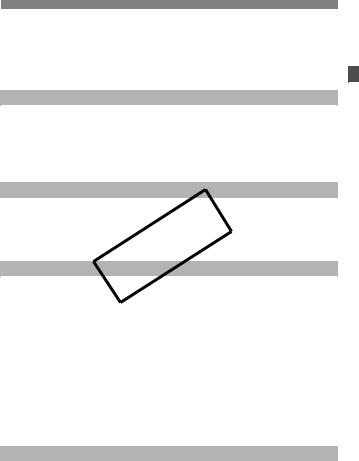
|
|
|
Contents |
|
Slide Show (Auto Playback)........................................................................... |
165 |
|
|
Viewing the Images on TV ............................................................................. |
167 |
|
|
KProtecting Images .................................................................................... |
170 |
|
|
LErasing Images |
......................................................................................... |
171 |
|
BShooting Information Display ................................................................ |
173 |
|
9 |
Printing Images |
175 |
|
|
Preparing to Print ........................................................................................... |
|
176 |
|
wPrinting...................................................................................................... |
|
178 |
|
Trimming the Image .................................................................................... |
183 |
|
|
WDigital Print Order Format (DPOF) ........................................................... |
185 |
|
|
Direct Printing with DPOF .............................................................................. |
188 |
|
10 |
Customizing the Camera |
189 |
|
|
Setting Custom Functions .............................................................................. |
190 |
|
|
Custom Function Settings .............................................................................. |
192 |
|
|
|
COPY |
|
|
Registering My Menu ..................................................................................... |
198 |
|
|
Setting Copyright Information......................................................................... |
199 |
|
11 |
Reference |
|
201 |
|
When Autofocus Fails .................................................................................... |
202 |
|
|
Using a Household Power Outlet ................................................................... |
203 |
|
|
Remote Control Shooting............................................................................... |
204 |
|
|
External Speedlites ........................................................................................ |
206 |
|
|
Using Eye-Fi Cards ........................................................................................ |
208 |
|
|
Function Availability Table according to Shooting Modes.............................. |
210 |
|
|
Menu Settings ................................................................................................ |
|
212 |
|
System Map ................................................................................................... |
|
216 |
|
Troubleshooting Guide................................................................................... |
218 |
|
|
Error Codes.................................................................................................... |
|
224 |
|
Specifications ................................................................................................. |
|
225 |
|
Index .............................................................................................................. |
|
237 |
End Pages: Quick Reference Guide and Software Start Guide |
243 |
||
9
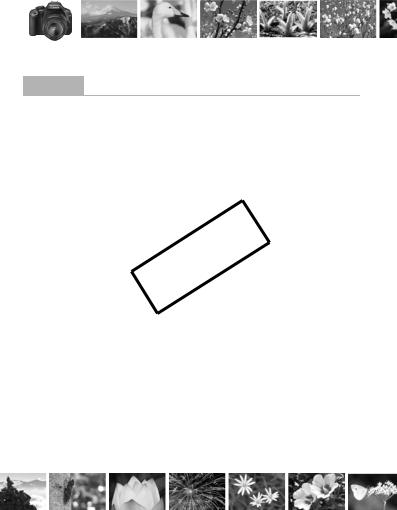
Contents at a Glance
Shooting
Shoot automatically |
|
Î p.45 - 57 (Basic Zone modes) |
|||
|
|
||||
Shoot continuously |
Î p.50, 53, 70 (iContinuous shooting) |
||||
|
|
||||
Take a picture of yourself in a group Î p.71 |
(jSelf-timer) |
||||
|
|
|
|
|
|
Freeze the action |
|
|
|
|
|
Blur the action |
|
|
Î p.78 |
(sShutter-priority AE) |
|
|
|
|
|
||
Blur the background |
|
|
|
||
Keep the background in sharp focus |
Î p.80 |
(fAperture-priority AE) |
|||
|
|
|
|||
|
|
COPY |
|||
Adjust the image brightness (exposure) Î p.87 |
(Exposure compensation) |
||||
Shoot in low light |
|
|
Î p.46, 62, 64 (DFlash photography) |
||
Shoot without flash |
|
|
Î p.49 |
(7Flash Off) |
|
|
|
|
|||
Photograph fireworks at night |
Î p.84 |
(Bulb exposure) |
|||
|
|||||
Shoot while viewing the LCD monitor Î p.108 (ALive View shooting) |
|||||
|
|
|
|
||
Shoot movies |
|
|
Î p.124 (kMovie shooting) |
||
|
|
|
|
|
|
Image Quality |
|
|
|
|
|
Shoot with image effects |
|
Î p.75 |
|
||
matching the subject |
|
(Selecting a Picture Style) |
|||
10
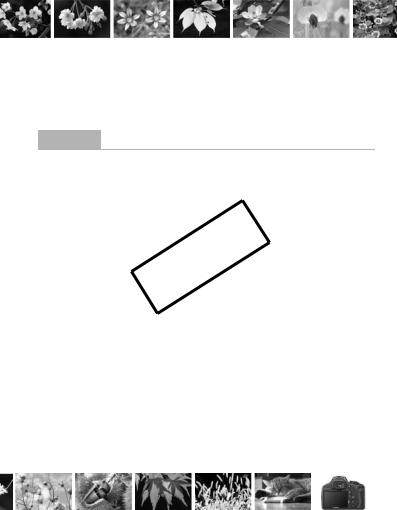
|
|
|
|
|
|
|
Make a large-size print of the picture Î p.72 |
(73, 83, 1) |
|
|
|
|
|
|
|||
|
|
|
|
|
|
|
Take many pictures |
Î p.72 |
(76, 86) |
|
|
Focusing
Change the point of focus |
Î p.68 (SAF point selection) |
|
|
Shoot a moving subject |
Î p.53, 67 (AI Servo AF) |
Playback |
|
|
|
|
|
|
COPY |
|
|
View the images with the camera |
Î p.58 (xPlayback) |
|||
Search for pictures quickly |
Î p.156 (HIndex display) |
|||
Prevent important images |
Î p.170 (KImage protect) |
|||
from accidental deletion |
||||
|
|
|||
Delete unnecessary images |
Î p.171 (LDelete) |
|||
|
|
|
||
View the images on a TV set |
Î p.167 |
(Video OUT) |
||
|
|
|
||
Set the LCD brightness |
Î p.139 |
(LCD brightness) |
||
|
|
|
|
|
Printing |
|
|
||
|
|
|
|
|
Print pictures easily |
Î p.175 |
(Direct printing) |
||
11
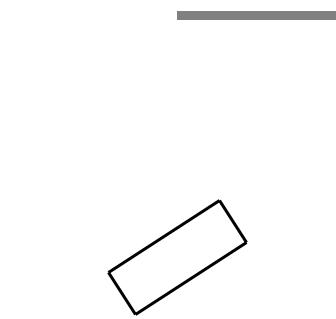
Handling Precautions
Camera Care
This camera is a precision instrument. Do not drop it or subject it to physical shock.
The camera is not waterproof and cannot be used underwater. If you accidentally drop the camera into water, promptly consult your nearest Canon Service Center. Wipe off any water droplets with a dry cloth. If the camera has been exposed to salty air, wipe it with a well-wrung wet cloth. Never leave the camera near anything having a strong magnetic field such as a magnet or electric motor. Also avoid using or leaving the camera near anything emitting strong radio waves such as a large antenna. Strong magnetic fields can cause camera misoperation or destroy image data.
Do not leave the camera in excessive heat such as in a car in direct sunlight. High temperatures can cause the camera to malfunction.
The camera contains precision electronic circuitry. Never attempt to disassemble the camera yourself.
Use a blower to blow away dust on the lens, viewfinder, reflex mirror, and focusing screen. Do not use cleaners that contain organic solvents to clean
the camera body or lens. For stubborn dirt, take the camera to the nearest |
|
Canon Service Center. |
COPY |
|
|
Do not touch the camera’s electrical contacts with your fingers. This is to prevent the contacts from corroding. Corroded contacts can cause camera misoperation.
If the camera is suddenly brought in from the cold into a warm room, condensation may form on the camera and internal parts. To prevent condensation, first put the camera in a sealed plastic bag and let it adjust to the warmer temperature before taking it out of the bag.
If condensation forms on the camera, do not use the camera. This is to avoid damaging the camera. If there is condensation, remove the lens, card and battery from the camera, and wait until the condensation has evaporated before using the camera.
If the camera will not be used for an extended period, remove the battery and store the camera in a cool, dry, well-ventilated location. Even while the camera is in storage, press the shutter button a few times once in a while to check that the camera is still working.
Avoid storing the camera where there are corrosive chemicals such as a darkroom or chemical lab.
If the camera has not been used for an extended period, test all its functions before using it. If you have not used the camera for some time or if there is an important shoot coming up, have the camera checked by your Canon dealer or check the camera yourself and make sure it is working properly.
12
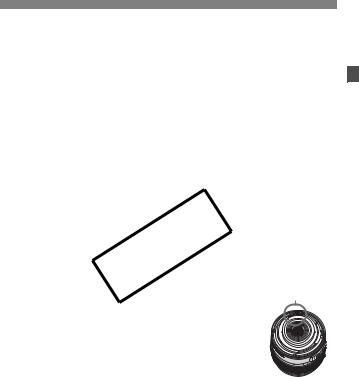
Handling Precautions
LCD Monitor
Although the LCD monitor is manufactured with very high precision technology with over 99.99% effective pixels, there might be a few dead pixels among the remaining 0.01% or less pixels. Dead pixels displaying only black or red, etc., are not a malfunction. They do not affect the images recorded.
If the LCD monitor is left on for a prolonged period, screen burn-in may occur where you see remnants of what was displayed. However, this is only temporary and will disappear when the camera is left unused for a few days. In low or high temperatures, the LCD monitor display may seem slow or it might look black. It will return to normal at room temperature.
Cards
To protect the card and its recorded data, note the following:
Do not drop, bend, or wet the card. Do not subject it to excessive force,
physical shock, or vibration. |
|
Do not store or use the card near anything having a strong magnetic field |
|
such as a TV set, speakers, or magnet. Also avoid places prone to having |
|
caps or put down the lensCOPYwith the rear end up to avoid |
|
static electricity. |
|
Do not leave the card in direct sunlight or near a heat source. |
|
Store the card in a case. |
|
Do not store the card in hot, dusty, or humid locations. |
|
Lens |
|
After detaching the lens from the camera, attach the lens |
Contacts |
scratching the lens surface and electrical contacts.
Cautions During Prolonged Use
If you use continuous shooting, Live View shooting, or movie shooting for a prolonged period, the camera may become hot. Although this is not a malfunction, holding the hot camera for a long period can cause slight skin burns.
About smear adhering to the front of the sensor
Besides dust entering the camera from outside, in rare cases lubricant from the camera’s internal parts may adhere to the front of the sensor. In case visible spots still remain after the automatic sensor cleaning, having the sensor cleaned by a Canon Service Center is recommended.
13
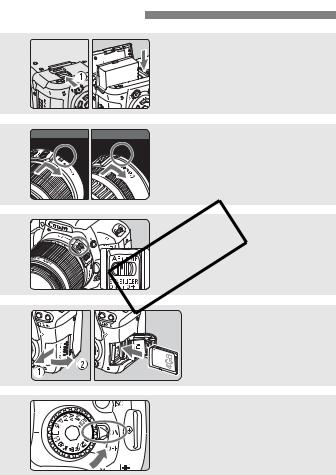
Quick Start Guide
1 
2  White index
White index
Insert the battery. (p.26)



 To charge the battery, see page 24.
To charge the battery, see page 24.
 Red index Attach the lens. (p.33)
Red index Attach the lens. (p.33)
Align the lens’ white or red index with
the camera’s index in the matching color.
3 |
Set the lens focus mode switch |
COPYOpen the slot cover and |
|
to <AF>. (p.33) |
|
4 |
insert a card. (p.31) |
|
With the card’s label facing you, |
|
insert it into the slot. |
5 |
Set the power switch to <1>. |
(p.27) |
When the LCD monitor displays the Date/Time setting screen, see page 29.
14
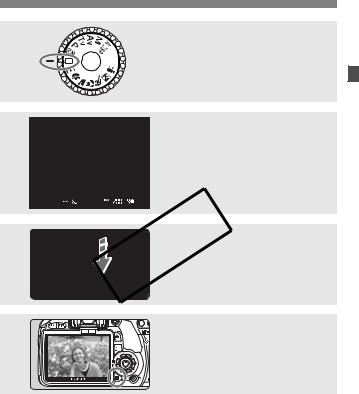
Quick Start Guide
6 |
Set the Mode Dial to <1> (Full |
Auto). (p.46) |
|
|
All the necessary camera settings will |
|
be set automatically. |
7 |
Focus the subject. (p.37) |
Look through the viewfinder and aim the |
|
|
viewfinder center over the subject. |
|
Press the shutter button halfway, and |
|
the camera will focus the subject. |
|
If necessary, the built-in flash will pop- |
|
up automatically. |
8 |
COPY |
Take the picture. (p.37) |
|
ress the shutter button completely to |
|
|
take the picture. |
9 |
Review the picture. (p.138) |
The captured image will be displayed |
|
|
for approx. 2 sec. on the LCD monitor. |
|
To display the image again, press the |
|
<x> button (p.58). |
The shooting settings displayed on the LCD monitor will turn off when your eye nears the viewfinder eyepiece.
To shoot while looking at the LCD monitor, see page 107. To delete an image, see “Erasing Images” (p.171).
15
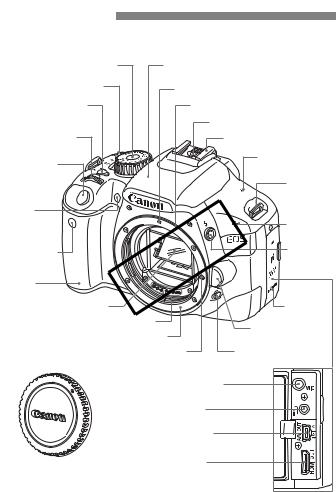
Nomenclature
The names in bold indicate the parts mentioned up until the “Basic Shooting and Image Playback” section.
Mode Dial (p.20) |
|
Built-in flash/AF-assist beam |
|
|
|
|
(p.64/147) |
|
|
Power switch (p.27) |
|
EF Lens mount index (p.33) |
|
|
|
|
|
||
<Z> ISO speed |
|
EF-S Lens mount index (p.33) |
||
setting button (p.62) |
|
|
|
|
|
|
Flash-sync contacts |
|
|
<6> Main Dial |
|
Hot shoe (p.206) |
|
|
(p.4) |
|
|
||
|
|
|
||
Shutter button |
|
<V> Focal plane |
||
|
mark (p.52) |
|||
(p.37) |
|
|||
|
|
|
||
|
|
|
Strap mount |
|
|
|
|
(p.23) |
|
Red-eye |
|
|
|
|
reduction/ |
|
|
Microphone |
|
Self-timer |
|
|
||
COPY |
(p.134) |
|||
lamp (p.65/71) |
||||
|
|
|||
Remote control |
|
|
<D> Flash |
|
|
|
button (p.64) |
||
sensor |
|
|
||
|
|
|
||
(p.106,204) |
|
|
|
|
Grip |
|
|
|
|
Mirror (p.106,153) |
|
|
Terminal |
|
|
|
|
||
Contacts (p.13) |
|
cover |
||
|
|
|||
|
Lens release button |
Lens mount |
(p.34) |
Lens lock pin |
Depth-of-field preview |
|
button (p.82) |
External microphone
IN terminal (p.134)
Remote control terminal (p.205)
Audio/video OUT/
Digital terminal (p.169,176)
Body cap (p.33) |
HDMI mini OUT |
|
terminal (p.167) |
||
|
16
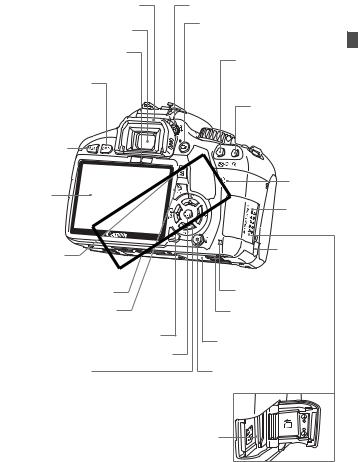
Nomenclature
|
|
Eyecup (p.205) |
Dioptric adjustment knob (p.36) |
<A> Live View shooting/ Viewfinder eyepiece Movie shooting button
(p.108/124)
Display-off sensor (p.146)
|
|
<A/I> AE lock/ |
|
|
|
FE lock button/ |
|
<B> Shooting |
|
Index/Reduce button |
|
|
(p.97/98/156/158,183) |
||
settings display |
|
||
|
|
||
button |
|
<S/u> |
|
(p.44,110,126, |
|
||
|
AF point selection/ |
||
143,173) |
|
||
|
Magnify button |
||
|
|
||
|
|
(p.68/158,183) |
|
<M> Menu |
|
|
|
button (p.40) |
|
|
|
|
COPY |
Speaker |
|
LCD monitor |
(p.162) |
||
|
|||
|
|
||
(p.40,139) |
|
Card slot |
|
|
|
||
|
|
cover (p.31) |
|
<O> Aperture/ |
|
DC cord hole |
|
|
(p.203) |
||
Exposure compensation |
|
||
|
|
||
button (p.83/87) |
|
|
|
Tripod socket |
Access lamp (p.32) |
||
<Q/l> Quick Control button/ |
Battery compartment |
||
Direct print button (p.38/181) |
|||
cover release lever (p.26) |
|||
|
|
||
|
<x> Playback button (p.58) |
Battery compartment cover |
|
|
|
||
|
<0> Setting button (p.40) |
(p.26) |
|
|
|
||
<S> Cross keys (p.40) |
<L> Erase button (p.171) |
||
<WB> White balance selection button (p.99) |
|
||
<XA> Picture Style selection button (p.75) |
|
||
<Yi/Q> Drive mode selection button (p.70,71) |
|
||
<ZE> |
AF mode selection button (p.66) |
|
|
Card slot (p.31)
17
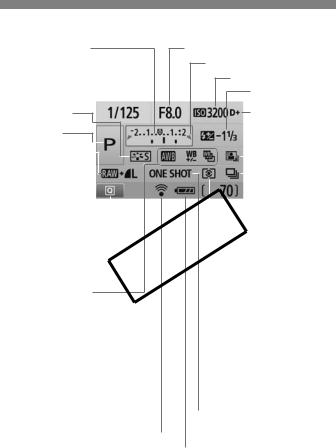
Nomenclature
Shooting Settings Display
Exposure level indicator
Exposure compensation amount (p.87) AEB range (p.89)
Shutter speed 
Picture Style (p.75)
Shooting mode
Aperture
cMain Dial pointer (p.77)
ISO speed (p.62)
Flash exposure compensation (p.88)
Highlight tone priority (p.194)
|
|
|
|
|
|
|
|
|
|
|
|
|
|
|
|
|
|
|
|
|
|
|
|
|
|
Auto Lighting |
Image-recording |
|
|
|
|
|
|
|
|
|
|
|
|
|
|
|
|
|
|
|
Optimizer (p.103) |
||||||
quality (p.72) |
|
|
|
|
|
|
|
|
|
|
|
|
|
|
|
|
|
|
|
|||||||
73 |
Large/Fine |
|
|
|
|
|
|
|
|
|
|
|
|
|
|
|
|
|
|
Drive mode (p.70,71) |
||||||
|
|
|
|
|
|
|
|
|
|
|
|
|
|
|
|
|
|
|
|
|
||||||
83 |
Large/Normal |
|
|
|
|
|
|
|
|
|
|
|
|
|
|
|
|
|
u Single shooting |
|||||||
|
|
|
|
|
|
|
|
|
|
|
|
|
|
|
|
|
||||||||||
74 |
Medium/Fine |
|
|
|
|
|
|
|
|
|
|
|
|
|
|
|
|
|
|
|
i Continuous |
|||||
|
|
|
|
|
|
|
|
|
|
|
|
|
|
|
|
|
||||||||||
84 |
Medium/Normal |
|
|
|
|
|
|
|
|
|
|
|
|
|
|
|
|
|
|
|
shooting |
|||||
76 |
Small/Fine |
|
|
COPY |
|
|
|
|
|
|
|
Q Self-timer/ |
||||||||||||||
86 |
Small/Normal |
|
|
|
|
|
|
|
|
Remote control |
||||||||||||||||
|
|
|
|
|
|
|
|
|
|
|
|
|
|
|
|
|
|
|
||||||||
|
|
|
|
|
|
|
|
|
|
|
|
|
|
|
|
|
|
|
l Self-timer:2 sec |
|||||||
1 |
RAW |
|
|
|
|
|
|
|
|
|
|
|
|
|
|
|
|
|
|
|
||||||
|
|
|
|
|
|
|
|
|
|
|
|
|
|
|
|
|
|
|
qSelf-timer: |
|||||||
1+73RAW+Large/Fine |
|
|
|
|
|
|
|
|
|
|
|
|
|
|
|
|
|
|
|
|||||||
|
|
|
|
|
|
|
|
|
|
|
|
|
|
|
|
|
|
|
Continuous |
|||||||
|
|
|
|
|
|
|
|
|
|
|
|
|
|
|
|
|
|
|
|
|
|
|
|
|
|
|
Quick Control icon (p.38) |
|
|
|
|
|
|
|
|
|
|
|
|
|
|
|
|
|
|
|
|
Shots remaining |
|||||
|
|
|
|
|
|
|
|
|
|
|
|
|
|
|
|
|
|
|
||||||||
|
|
|
|
|
|
|
|
|
|
|
|
|
|
|
||||||||||||
|
|
|
|
|
|
|
|
|
|
|
|
|
|
|
|
|
|
|
|
|
|
|
|
|||
White balance (p.99) |
|
|
|
|
|
|
|
|
|
|
|
|
|
|
|
Shots remaining during |
||||||||||
|
|
|
|
|
|
|
|
|
|
|
|
|
|
|
||||||||||||
|
|
|
|
|
|
|
|
|
|
|
|
|
|
|
WB bracketing |
|||||||||||
|
QAuto |
|
|
|
|
|
|
|
|
|
|
|
|
|
|
|
||||||||||
|
|
|
|
|
|
|
|
|
|
|
|
|
|
|
|
Self-timer countdown |
||||||||||
|
W Daylight |
|
|
|
|
|
|
|
|
|
|
|
|
|
|
|
||||||||||
|
|
|
|
|
|
|
|
|
|
|
|
|
|
|
|
|||||||||||
|
|
|
|
|
|
|
|
|
|
|
|
|
|
|
|
Bulb exposure time |
||||||||||
|
EShade |
|
|
|
|
|
|
|
|
|
|
|
|
|
|
|
||||||||||
|
|
|
|
|
|
|
|
|
|
|
|
|
|
|
|
|
|
|
||||||||
|
RCloudy |
|
|
|
|
|
|
|
|
|
|
|
|
Metering mode (p.86) |
||||||||||||
|
|
|
|
|
|
|
|
|
|
|
|
|
||||||||||||||
|
YTungsten light |
|
|
|
|
|
|
|
|
|
|
|
|
qEvaluative metering |
||||||||||||
|
U White fluorescent light |
|
|
|
|
|
|
|
|
|
|
|
|
wPartial metering |
||||||||||||
|
I Flash |
|
|
|
|
|
|
|
|
|
|
|
|
rSpot metering |
||||||||||||
|
OCustom |
|
|
|
|
|
|
|
|
|
|
|
|
eCenter-weighted |
||||||||||||
2White balance correction (p.101) |
|
|
|
|
|
|
average metering |
|||||||||||||||||||
|
|
|
|
|
|
|
|
|
|
|||||||||||||||||
BWhite balance bracketing (p.102) |
|
|
|
AF mode (p.66) |
||||||||||||||||||||||
|
|
|
||||||||||||||||||||||||
|
|
|
|
|
|
|
|
|
|
|
|
|
|
|
|
|
|
|
|
X One-Shot AF |
||||||
Eye-Fi transmission status* (p.208) |
|
|
|
|
|
|
|
|
9AI Focus AF |
|||||||||||||||||
|
|
|
|
|
|
|
|
|||||||||||||||||||
|
|
|
|
|
|
|
|
|
|
|
|
|
|
|
|
|
|
|
|
|||||||
|
|
|
Battery check (p.28) |
|
|
|
|
|
Z AI Servo AF |
|||||||||||||||||
|
|
|
|
|
|
|||||||||||||||||||||
|
|
|
zxcn |
|
|
|
g |
|
|
|
Manual Focusing |
|||||||||||||||
* Displayed if an Eye-Fi card is used.
The display will show only the settings currently applied.
18

Nomenclature
Viewfinder Information
Spot metering circle |
|
|
|
AF point activation indicator < > |
|
||||
Focusing screen |
|
|
|
|
|
|
|
AF points |
|
|
|
|
|
|
|
|
|
|
|
|
|
|
|
|
|
|
|
|
|
|
|
|
|
|
|
|
|
|
|
|
|
|
|
|
|
|
|
|
|
|
|
|
|
|
|
|
|
|
|
<Z> ISO speed
<2>
<A> AE lock/  AEB in-progress
AEB in-progress
<D> Flash-ready 
Improper FE lock warning
 COPY
COPY



White balance correction
<o> Focus confirmation light
Max. burst
<0> Monochrome shooting
<e> High-speed sync (FP flash)
<d> FE lock/
FEB in-progress
<y> Flash exposure compensation
Shutter speed
FE lock (FEL)
Busy (buSY)
Built-in flash recycling (DbuSY)
ISO speed
<A> Highlight tone priority
Exposure level indicator
Exposure compensation amount AEB range
Red-eye reduction lamp-on indicator
Aperture
Card full warning (FuLL)
Card error warning (Err)
No card warning (Card)
The display will show only the settings currently applied.
19
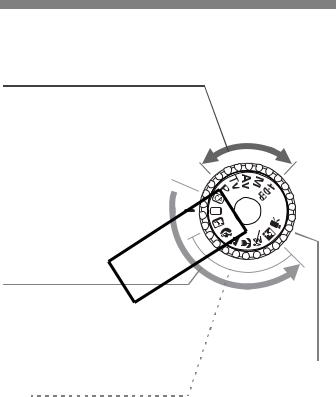
Nomenclature
Mode Dial
The Mode Dial includes the Basic Zone modes, Creative Zone modes, and Movie shooting mode.
Creative Zone
These modes give you more control for shooting various subjects.
d : Program AE (p.60)
s : Shutter-priority AE (p.78)
f : Aperture-priority AE (p.80) a : Manual exposure (p.83) 8: Automatic depth-of-field 
AE (p.85)
All you do is press the shutterCOPYbutton. Fully-automatic shooting suiting the
subject.
1: Full Auto (p.46)
C: Creative Auto (p.55)
k: Movie shooting
Image Zone |
(p.123) |
|
7: Flash Off (p.49)
2: Portrait (p.50)
3: Landscape (p.51)
4: Close-up (p.52)
5: Sports (p.53)
6: Night Portrait (p.54)
20

Nomenclature
Lens
Lens without a distance scale
Focusing ring (p.69,120) |
Focus mode switch (p.33) |
|
Zoom ring (p.34) |
Hood mount |
Zoom position index (p.34) |
(p.231) |
|
Filter thread
(front of lens) (p.231)
Image Stabilizer switch (p.35) |
|
|
Lens mount index (p.33) |
|
Contacts (p.13) |
Lens with a distance scale |
|
|
|
Focus mode switch (p.33) |
|
Hood mountCOPY |
|
|
(p.231) |
|
|
|
|
Zoom position index (p.34) |
|
|
Distance scale |
Filter thread |
|
|
(front of lens) (p.231) |
|
|
Zoom ring (p.34)
Focusing ring (p.69,120)
Contacts (p.13)
Image Stabilizer switch (p.35) |
Lens mount index (p.33) |
21
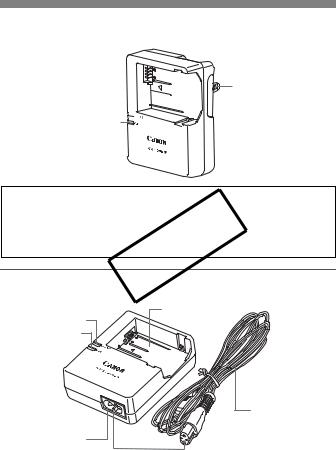
Nomenclature
Battery Charger LC-E8
Charger for Battery Pack LP-E8 (p.24).
Power plug
Battery pack slot 
Charge lamp 



Full-charge lamp 
IMPORTANT SAFETY INSTRUCTIONS-SAVE THESE INSTRUCTIONS. DANGER-TO REDUCE THE RISK OF FIRE OR ELECTRIC SHOCK, CAREFULLY FOLLOW THESE INSTRUCTIONS.
For connection to a supplyCOnot in the U.S.A.,PYuse an attachment plug adapter of the proper configuration for the power outlet, if needed.
Battery Charger LC-E8E
Charger for Battery Pack LP-E8 (p.24).
Battery pack slot
Charge lamp
Full-charge lamp
Power cord
Power cord socket
22

Getting Started
This chapter explains preparatory steps before you start shooting and basic COPYcamera operations.
Attaching the Strap
Pass the end of the strap through the camera’s strap mount eyelet
from the bottom. Then pass it
through the strap’s buckle as shown
in the illustration. Pull the strap to
take up any slack and make sure
the strap will not loosen from the
buckle.
The eyepiece cover is also attached to the strap (p.205).
Eyepiece cover
23
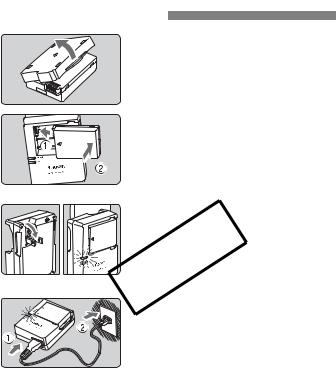
Charging the Battery
LC-E8
LC-E8E
1 Remove the protective cover.
2 Attach the battery.
As shown in the illustration, attach the battery securely.
To detach the battery, follow the above procedure in reverse.
3 Recharge the battery. For LC-E8
As shown by the arrow, flip out the COPYbattery charger’s prongs and insert
the prongs into a power outlet.
For LC-E8E
Connect the power cord to the charger and insert the plug into the power outlet.
XRecharging starts automatically and the charge lamp turns orange.
XWhen the battery is fully recharged,
the full-charge lamp will turn green.
It takes approx. 2 hours to fully recharge a completely exhausted battery at 23°C / 73°F. The time required to recharge the battery depends on the ambient temperature and battery’s charge level.
For safety reasons, recharging in low temperatures (6°C - 10°C / 43°F - 50°F) will take a longer time (up to 4 hours).
24

Charging the Battery




 Tips for Using the Battery and Charger
Tips for Using the Battery and Charger
Recharge the battery on the day before or on the day it is to be used.
Even during storage, a charged battery will gradually discharge and lose its power.
After recharging the battery, detach it and unplug the charger from the power outlet.
When not using the camera, remove the battery.
If the battery is left in the camera for a prolonged period, a small amount of power current is released, resulting in excess discharge and shorter battery life. Store the battery with the protective cover attached. Storing the battery after it is fully charged can lower the battery’s performance.
The battery chargerCOPYcan also be used in foreign countries.
The battery charger is compatible with a 100 V AC to 240 V AC 50/ 60 Hz power source. If necessary, attach a commercially-available plug adapter for the respective country or region. Do not attach any portable voltage transformer to the battery charger. Doing so can damage the battery charger.
If the battery becomes exhausted quickly even after being fully charged, the battery has reached the end of its service life.
Purchase a new battery.
Do not charge any battery other than the Battery Pack LP-E8.
The Battery Pack LP-E8 is dedicated to Canon products only. Using it with an incompatible battery charger or product may result in malfunction or accidents for which Canon cannot be held liable.
25
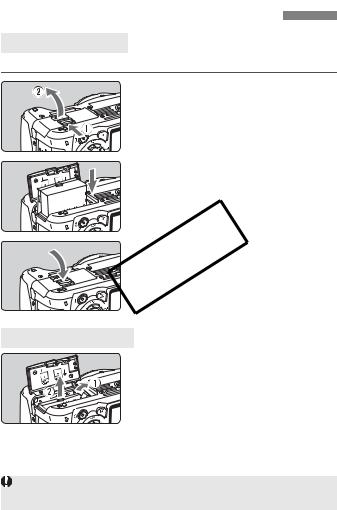
Installing and Removing the Battery 
Installing the Battery
Load a fully charged Battery Pack LP-E8 into the camera.
1 |
Open the battery compartment |
|
cover. |
|
Slide the lever as shown by the arrow |
|
and open the cover. |
2 Insert the battery. |
|
|
Insert the end with the battery |
|
contacts. |
|
Insert the battery until it locks in |
|
place. |
COPY |
|
3 Close the cover.
Press the cover until it snaps shut.
Removing the Battery
Open the cover and remove the battery.
Press the battery release lever as
shown by the arrow and remove the
battery.
To prevent short circuiting, be sure to attach the protective cover to the battery.
After opening the battery compartment cover, be careful not to swing it back further. Otherwise, the hinge might break.
26
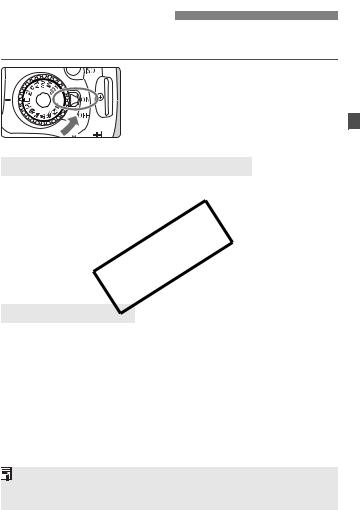
Turning on the Power
If the date/time setting screen appears when you turn on the power switch, see page 29 to set the date/time.
<1> : The camera turns on. <2> : The camera is turned off and
does not operate. Set to this position when not using the camera.
About the Automatic Self-Cleaning Sensor
Whenever you set the power switch to <1> or <2>, the sensor cleaning will be executed automatically. During the sensor cleaning, the LCD monitor will display <f>. Even during the sensor cleaning, you can still shoot by pressing the shutter button halfway (p.37) to stop the sensorCOPYcleaning and take a picture.
If you repeatedly turn the power switch <1>/<2> at a short interval, the <f> icon might not be displayed. This is normal and not a problem.
About Auto Power Off
To save battery power, the camera turns off automatically after about 30 seconds of non-operation. To turn on the camera again, just press the shutter button halfway (p.37).
You can change the auto power-off time with the menu’s [5Auto power off] setting (p.139).
If you set the power switch to <2> while an image is being recorded to the card, [Recording ...] will be displayed and the power will turn off after the card finishes recording the image.
27
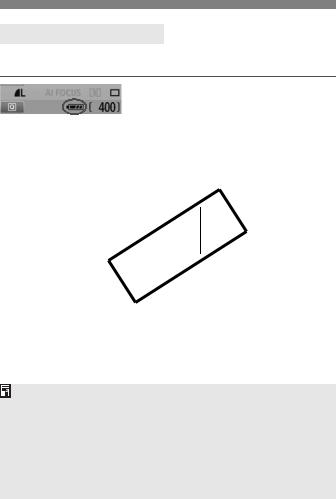
Turning on the Power
Checking the Battery Level
When the power switch is set to <1>, the battery level will be indicated in one of four levels:
z : Battery level is OK.
x : Battery level is slightly down,
|
but adequate power remains. |
||
|
c : Battery will be exhausted soon. |
||
|
n : Battery must be recharged. |
||
Battery Life |
|
|
|
|
|
|
|
Temperature |
At 23°C / 73°F |
At 0°C / 32°F |
|
No Flash |
COPY |
|
|
Approx. 550 shots |
Approx. 470 shots |
|
|
50% Flash Use |
Approx. 440 shots |
Approx. 400 shots |
|
The figures above are based on a fully-charged Battery Pack LP-E8, no Live View shooting, and CIPA ( amera & Imaging Products Association) testing standards.
The Battery Grip BG-E8 approximately doubles the number of possible shots with two LP-E8 batteries installed. With size-AA/LR6 alkaline batteries, the number of possible shots at 23°C / 73°F is approx. 470 shots without flash use and approx. 270 shots with 50% flash use.
The number of possible shots will decrease with any of the following operations:
•Pressing the shutter button halfway for a prolonged period.
•Often activating only the AF without taking a picture.
•Using the LCD monitor often.
•Using the lens Image Stabilizer.
The lens operation is powered by the camera’s battery. Depending on the lens used, the number of possible shots may be lower.
For battery life with Live View shooting, see page 109.
28

3Setting the Date and Time 
When you turn on the power for the first time or if the date/time has been reset, the Date/Time setting screen will appear. Follow steps 3 and 4 to set the date/time. Note that the date/time appended to recorded images will be based on this date/time setting. Be sure to set the correct date/time.

 1 Display the menu.
1 Display the menu.
Press the <M> button to display the menu.
 2 UnderTime]. the [6] tab, select [Date/
2 UnderTime]. the [6] tab, select [Date/
Press the <U> key to select the





 [6] tab. COPYress the <V> key to select [Date/
[6] tab. COPYress the <V> key to select [Date/
Time], then press <0>.
3 Set the date and time.
Press the <U> key to select the date or time number.
Press <0> so <a> is displayed. Press the <V> key to set the number, then press <0>. (Returns to b.)
4 Exit the setting.
Press the <U> key to select [OK], then press <0>.
XThe date/time will be set.
Press the <M> button to return to the shooting settings display.
The date/time set will start from when you press <0> in step 4.
If you store the camera without the battery or if the camera’s battery becomes exhausted, the date/time might be reset. If this happens, set the date/time again.
29
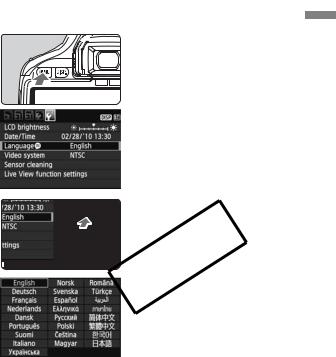
3Selecting the Interface Language 

 1 Display the menu.
1 Display the menu.
Press the <M> button to display the menu.
2Under the [6] tab, select [LanguageK].
Press the <U> key to select the [6] tab.
Press the <V> key to select [LanguageK] (the third item from the top), then press <0>.




 COPY3 Set the desired language.
COPY3 Set the desired language.
Press the <V> key to select the language, then press <0>.
XThe interface language will change. Press the <M> button to return
to the shooting settings display.
30
